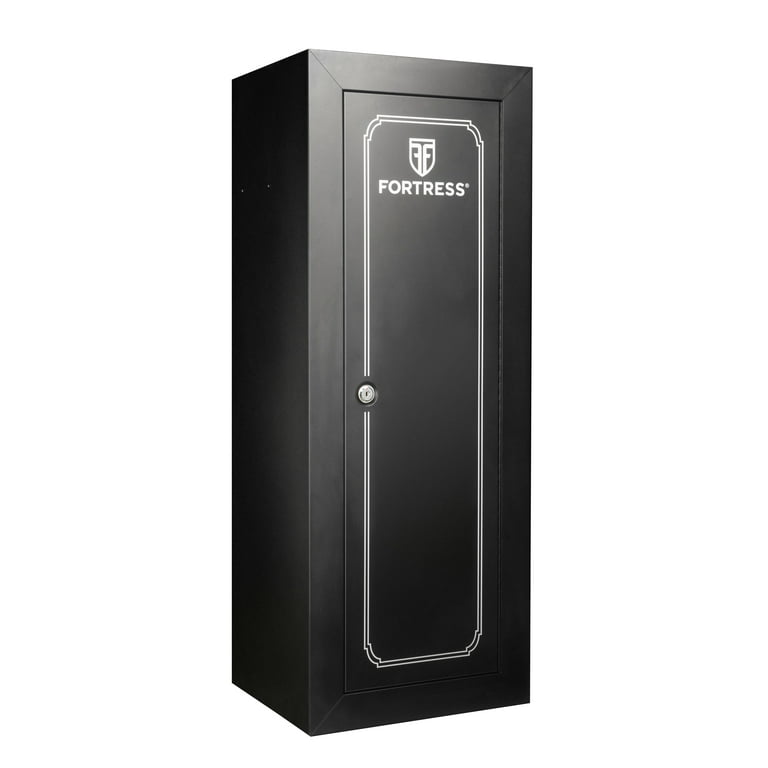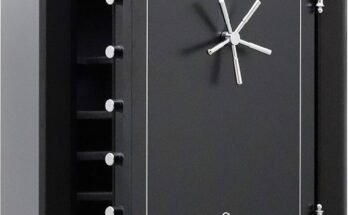Gun safes vary in fire protection, typically offering 30 minutes to 2 hours of resistance. Manufacturers design gun safes to protect against heat, smoke, and water during a fire.
Choosing the right gun safe for your firearms requires considering several aspects: security, capacity, and fire resistance. Gun safes play a pivotal role in both deterring theft and protecting your valuable firearms from fire damage. High-quality gun safes can withstand extreme temperatures, maintaining an internal temperature that will not damage the contents.
They are rated by their fire resistance level, which indicates the duration they can endure high temperatures before the interior heats up to damaging levels. Consumers must scrutinize the fire rating, which is a critical factor assessed alongside physical security features. As gun owners look to safeguard their investments from all types of threats, a robust fireproof gun safe stands as an essential addition to their security measures. Whether you’re a casual owner or a serious collector, understanding and investing in a well-rated fireproof gun safe can make a significant difference in the event of a disaster.
The Quest For Fireproof Gun Safes
Fire safety is a key part in safeguarding valuable items. Gun safes are no exception. Owners want to protect their firearms from fire. A safe that withstands high temperatures is crucial. This guide dives into fireproof gun safes and their importance.
Why Fire Resistance Matters For Gun Owners
Protecting firearms and ammo from fire is essential. Guns are investments and heirlooms. A fireproof safe helps maintain their condition. It also prevents ammo explosions which can cause more damage.
- Safety: Fireproof safes protect not only guns but also the home and people in it.
- Peace of Mind: Knowing your firearms are safe offers comfort.
- Compliance: Certain laws may require fireproof storage for firearms.
Common Misconceptions About Gun Safe Fireproofing
Fireproofing is widely misunderstood. Let’s clear up some myths:
| Misconception | Truth |
|---|---|
| All gun safes are fireproof. | Not all safes offer fire protection. Check the rating. |
| A higher price equals better fireproofing. | Cost doesn’t always reflect fire resistance quality. |
| Thicker walls mean better protection. | Material matters more than thickness for fire resistance. |

Credit: www.amazon.com
Decoding Fireproof Ratings
Interested in how well gun safes protect against fire? Understanding fireproof ratings unlocks the truth behind their defenses. Ratings are not just numbers; they tell a story of resilience and safety. Let’s dive into the specifics of these important figures.
Standards And Testing Methods
Testing methods for gun safe fireproofing follow strict protocols. These standards assess how safes withstand extreme temperatures.
Independent labs conduct tests, simulating intense heat conditions. Temperatures can soar to levels mimicking house fires.
- Heat sensors and paper placed inside safes reveal internal conditions.
- Time-temperature curve simulates real fire scenarios.
- Duration is key, with safes rated based on time they withstand fire.
Labs then assign heat resistance ratings, following industry benchmarks such as UL standards.
Interpreting Fireproof Labels And Certifications
Fireproof labels on gun safes indicate performance under fire. Labels list ratings that show temperature limits and time frames.
Look for three critical components on a label:
- Maximum internal temperature safe can reach during the test.
- Length of time the safe can maintain that temperature.
- Testing laboratory certifications, such as UL (Underwriters Laboratories).
Certifications ensure safes meet safety expectations. Examine labels closely before purchase.
Remember, not all safes have the same fireproof capabilities. The fine print can mean the difference between protected and lost valuables in a fire.
Materials And Construction
Understanding how gun safes resist fire involves a peek into their materials and construction. Manufacturers design these safes to shield contents from high temperatures. Durability and protection are at the forefront of these designs. Let’s delve into the layers and components that give gun safes their fireproofing prowess.
Layers And Components
The outer shell of a gun safe often features solid steel, which offers structural integrity. However, the secret to fire resistance lies within the layers.
- Composite layers are common, containing a mix of materials to combat heat.
- Some have a layer of fireboard or ceramic, which offer added resistance.
- Seals around the door expand when heated, locking out fire and smoke.
Impact Of Insulation On Fire Resistance
Insulation is pivotal in determining a safe’s fire resistance. Good insulation keeps internal temperatures low.
| Material | Benefits |
|---|---|
| Gypsum | Releases water vapor when heated, helping cool the interior. |
| Concrete-based amalgamate | It’s dense and holds back heat effectively. |
| Mineral wool | High melting point, excellent for insulation. |
Look for safes with UL ratings that detail fire endurance tests. Ratings indicate effectiveness and duration of resistance.

Credit: www.lowes.com
Real-world Fire Incidents And Gun Safes
When thinking about the security of firearms, a robust gun safe is crucial. Not only does it need to prevent unauthorized access, but it should also offer protection against fires. Advertisements may boast impressive fireproof ratings, but how do these safes actually fare in the face of a real-world inferno? This section delves into tales of survival and the stark realities faced when flames meet gun safes.
Case Studies And Survivor Stories
Real incidents serve as valuable lessons in assessing the fireproof capabilities of gun safes. Here are some notable examples:
- A home in California – Despite wildfires reducing the house to ashes, the gun safe inside emerged victorious, protecting the firearms within.
- A Texas blaze – A family’s residence burned, but their gun safe withstood the intense heat, preserving treasured heirlooms.
These stories highlight that while not invincible, quality gun safes can offer substantial protection in many fire scenarios.
Limitations Of Fireproof Safes In Extreme Conditions
It’s vital to recognize that “fireproof” doesn’t mean invulnerable. Extreme conditions can push a safe beyond its limits.
| Factor | Effect on Gun Safes |
|---|---|
| Duration | Extended exposure to fire can compromise integrity. |
| Temperature | Very high temperatures can reduce protective capabilities. |
| Construction | Poorly constructed safes may fail earlier than expected. |
Safes have ratings indicating the maximum temperature they can withstand and for how long. It’s crucial to match the safe’s rating with the individual’s needs.
Enhancing Protection
When it comes to safeguarding firearms, a gun safe’s fireproof qualities are top priority for many owners. Enhancing protection against fire means understanding the capabilities of your gun safe and taking additional steps to improve them.
Safe Placement And Installation Tips
The correct placement and installation of your gun safe can drastically increase its ability to withstand fire. Consider these tips for optimal placement:
- Avoid exterior walls: External temperatures can affect the safe more quickly.
- Choose the basement: It’s often the last place to catch fire in a home.
- Stay off the floor: Raise the safe to prevent heat transfer from hot surfaces.
Additional Measures For Fireproofing Gun Safes
While gun safes come with their own fire ratings, you can boost their resistance with extra steps.
Here’s what you can do:
| Measure | Effect |
|---|---|
| Add fireboards: | Enhances the fire-resistance level. |
| Install heat seals: | Prevents smoke and heat from entering. |
| Seal interior: | Secures the seams to block heat. |

Credit: www.walmart.com
Frequently Asked Questions On How Fireproof Are Gun Safes?
What Factors Determine A Gun Safe’s Fireproof Rating?
Fireproof ratings for gun safes are determined by the construction materials, thickness of the walls, type of fireproof insulation, and the quality of door seals. Manufacturers test safes under simulated fire conditions to establish these ratings.
How Long Can Gun Safes Withstand Fire?
Gun safes are rated by their fire resistance duration, typically ranging from 30 minutes to 2 hours. This indicates how long the safe can protect its contents at a specific temperature before the heat penetrates the interior.
Do All Gun Safes Offer Fire Protection?
Not all gun safes provide fire protection. Some are designed primarily for security against theft, whereas others incorporate fire-resistant materials and seals for dual-purpose protection. It’s critical to check the safe’s specifications.
What Is The Best Material For Fireproof Gun Safes?
The best material for fireproof gun safes is typically steel with a thick gauge, combined with fire-resistant composite material or ceramic wool for insulation. These components help in maintaining the internal temperature during a fire.
Conclusion
Understanding the fire-resistant capabilities of gun safes is essential. Not all units offer equal protection against high temperatures. Select safes with certified fire ratings to safeguard your firearms. Remember, investing in a quality fireproof gun safe is not just a choice, but a responsibility for any gun owner.
Choose wisely for maximum security and peace of mind.



